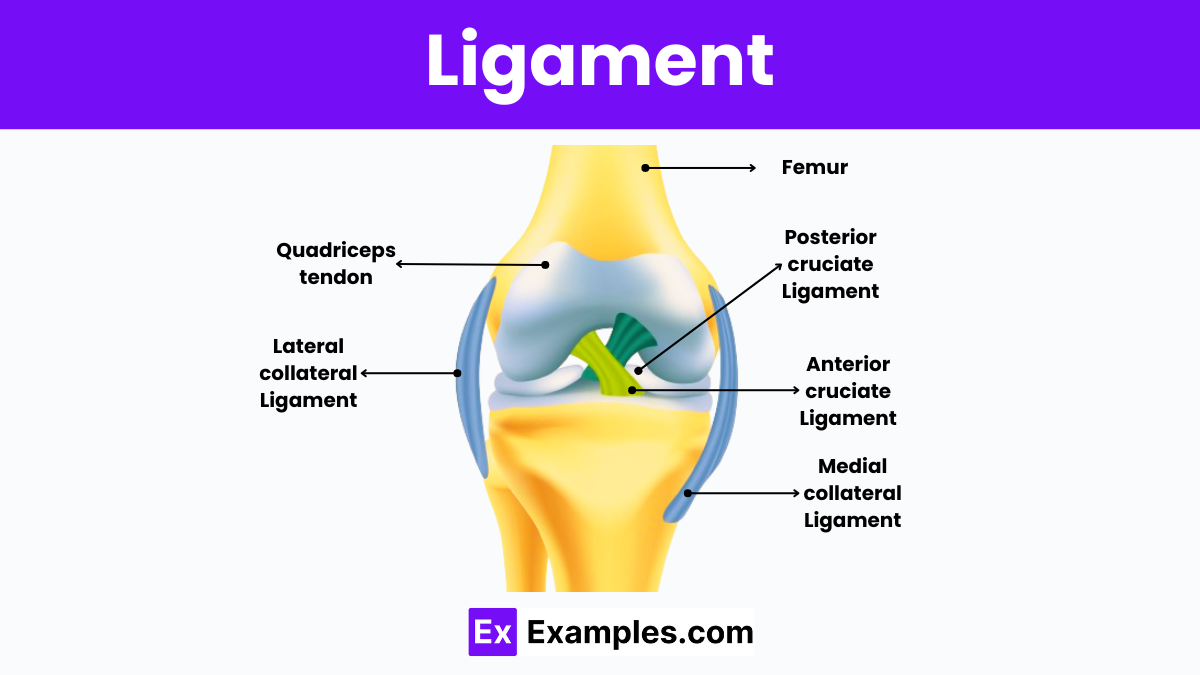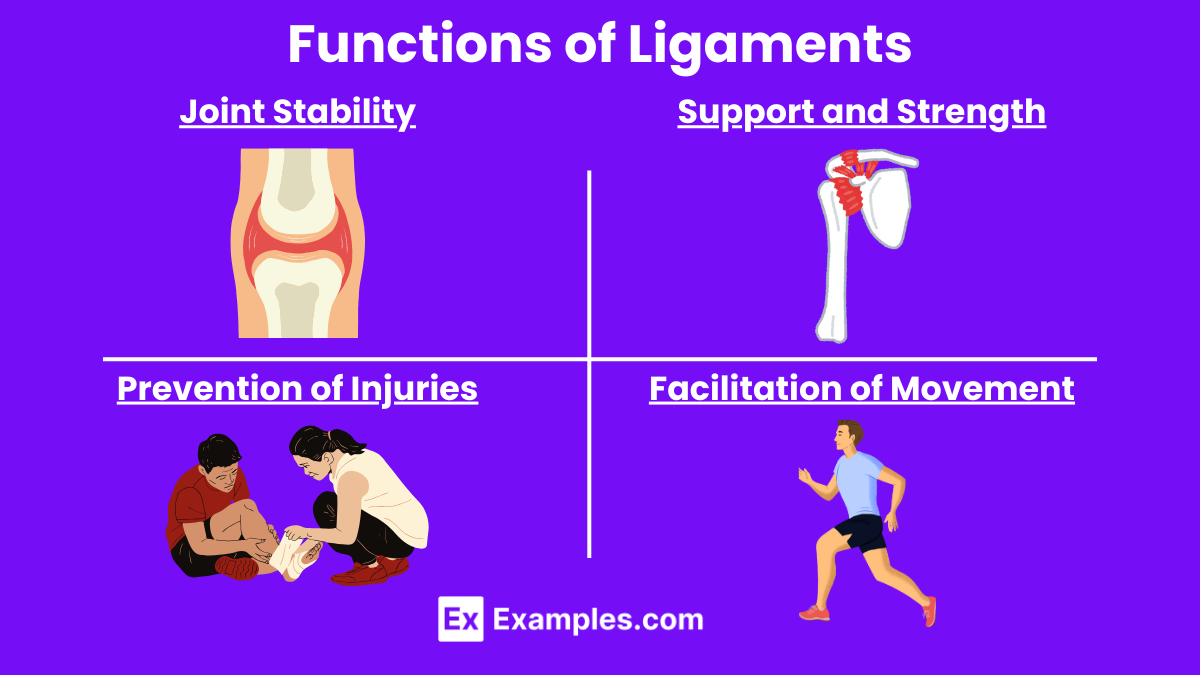Which of the following best describes the function of ligaments?
Connect muscles to bones
Connect bones to bones
Protect internal organs
Store calcium

Ligaments play a pivotal role in the human body, acting as critical components of the skeletal system. These sturdy bands of fibrous tissue connect bones to other bones at joints, providing essential support and stability. By maintaining the proper alignment and facilitating appropriate movement, ligaments prevent injuries while allowing the flexibility necessary for daily activities and athletic endeavors.
Ligaments are tough, flexible bands of fibrous connective tissue that connect bones to other bones at joints. They are essential components of the skeletal system, providing stability and support while allowing for necessary movement. Ligaments help to maintain proper alignment and prevent excessive movements that could damage joints and bones.
Articular ligaments directly connect bones within a joint, helping to stabilize and guide joint movements. They are typically found surrounding joints such as the knees, elbows, and shoulders. A prime example is the anterior cruciate ligament (ACL) in the knee, which helps control the movement of the joint and provides stability during physical activities.
These ligaments are part of the joint capsule that encloses certain joints. They are thicker parts of the joint capsule and help provide additional stability. Capsular ligaments are crucial in joints that undergo extensive movement, such as the shoulder joint, where they help prevent dislocations and maintain proper joint alignment.
Located outside the joint capsule, extracapsular ligaments provide additional support and stability, supplementing the structure of articular and capsular ligaments. They are often found in joints that bear significant weight or endure substantial stress, such as the knee. The lateral collateral ligament (LCL) of the knee is an example, offering stability against varus forces.
These ligaments are located inside the joint capsule but are excluded from the joint cavity by the synovial membrane. They are particularly important in the knee joint, where ligaments like the ACL and the posterior cruciate ligament (PCL) play critical roles in stabilizing the joint internally.
Elastic ligaments, such as those found in the vertebral column (ligamenta flava), contain more elastic fibers than typical fibrous ligaments. This composition allows them to stretch considerably and return to their original shape, supporting the body’s flexibility and movement, especially in the spine.

Ligaments are primarily made up of dense fibrous connective tissue. The main structural components of ligaments include
Ligaments generally have a limited blood supply, which is why they appear white and are known for slow healing processes after injury. Some ligaments, such as the ligamentum flavum, have a richer blood supply, contributing to their elasticity and quicker healing capabilities.
Nerve fibers are also present, which help in proprioception — the body’s ability to perceive its own position in space. These nerve endings help monitor the tension within the ligament and provide feedback to the brain, aiding in the coordination of movement and joint stability.
Ligaments attach to the periosteum, a dense layer of vascular connective tissue that covers the bones. This attachment is crucial as it anchors the ligaments firmly to the bones, allowing them to fulfill their role in stabilizing joints. The way ligaments are woven into the periosteum provides a secure attachment that supports the joint under various physical stresses.
Ligaments can adapt to changes in the mechanical demands placed upon them. Regular physical activity can lead to a strengthening of these structures, whereas a lack of movement can lead to their weakening. This adaptability highlights the importance of regular exercise in maintaining joint stability and ligament health.
The knee joint is stabilized by several crucial ligaments that include the Anterior Cruciate Ligament (ACL), Posterior Cruciate Ligament (PCL), Medial Collateral Ligament (MCL), and Lateral Collateral Ligament (LCL). The ACL and PCL cross each other inside the knee, working together to control the forward and backward motion of the tibia (shinbone) relative to the femur (thighbone). The MCL, located on the inner side of the knee, and the LCL, on the outer side, manage the sideways movements and overall stability of the knee. These ligaments are essential for maintaining knee stability during movement, supporting dynamic activities like walking, running, and turning, and protecting the knee from unnatural movements that could lead to injury.
Ligament injuries are common, particularly among athletes and individuals engaged in physical activities, but they can also occur during everyday activities. These injuries can range from mild sprains to severe tears, affecting the stability and function of the affected joint. Ligament injuries typically occur when a joint is stressed beyond its normal range of motion, often due to sudden twisting, stretching, or impact. Here’s how these injuries are classified
Artificial ligaments are synthetic structures designed to mimic the function of natural ligaments in the human body. These are typically used in cases where natural ligament repair is not possible or where previous surgeries have failed. Artificial ligaments offer an alternative to traditional surgical treatments like tendon grafts and are an area of significant interest in orthopedic and sports medicine.
The development of artificial ligaments has evolved over the years with advances in materials science and biomedical engineering. These synthetic ligaments are usually made from biocompatible materials that can withstand the mechanical stresses placed on joints during movement. Common materials include:
Tendons connect muscles to bones, while ligaments connect bones to bones, providing joint stability.
A broken ligament, often called a tear, causes joint pain, swelling, and instability.
Minor ligament injuries can heal on their own with rest and proper care, but severe tears may require surgery.
Ligament healing time varies, generally taking several weeks to months depending on injury severity and treatment.
Prompt medical treatment, rest, ice, compression, elevation (RICE), and physical therapy are the fastest ways to heal ligaments.
Text prompt
Add Tone
10 Examples of Public speaking
20 Examples of Gas lighting
Which of the following best describes the function of ligaments?
Connect muscles to bones
Connect bones to bones
Protect internal organs
Store calcium
Which of the following best describes the function of ligaments?
Muscle fibers
Collagen fibers
Nerve cells
Adipose tissue
Which ligament is found in the knee?
Anterior cruciate ligament (ACL)
Medial collateral ligament (MCL)
Lateral collateral ligament (LCL)
All of the above
What is the main role of the anterior cruciate ligament (ACL)?
To prevent forward movement of the tibia on the femur
To connect the patella to the tibia
To enable wrist movement
To cushion the spine
Damage to ligaments is commonly known as a:
Strain
Sprain
Fracture
Dislocation
The ligament that runs along the inner side of the knee is the:
Posterior cruciate ligament (PCL)
Lateral collateral ligament (LCL)
Medial collateral ligament (MCL)
Patellar ligament
Which ligament connects the femur to the pelvis?
Patellar ligament
Iliofemoral ligament
Anterior talofibular ligament
Cruciate ligament
The ligament that supports the front of the ankle is called the:
Calcaneofibular ligament
Anterior talofibular ligament
Posterior talofibular ligament
Deltoid ligament
What is the primary function of the ligaments in the spine?
To provide flexibility
To connect muscle to bone
To stabilize vertebrae
To aid in digestion
Which ligament is often injured in shoulder dislocations?
Acromioclavicular ligament
Glenohumeral ligament
Coracoclavicular ligament
Rotator cuff ligament
Before you leave, take our quick quiz to enhance your learning!

